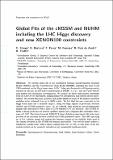Por favor, use este identificador para citar o enlazar a este item:
http://hdl.handle.net/10261/124712COMPARTIR / EXPORTAR:
 SHARE SHARE
 CORE
BASE CORE
BASE
|
|
| Visualizar otros formatos: MARC | Dublin Core | RDF | ORE | MODS | METS | DIDL | DATACITE | |

| Campo DC | Valor | Lengua/Idioma |
|---|---|---|
| dc.contributor.author | Strege, C. | es_ES |
| dc.contributor.author | Bertone, Gianfranco | es_ES |
| dc.contributor.author | Feroz, F. | es_ES |
| dc.contributor.author | Fornasa, Mattia | es_ES |
| dc.contributor.author | Ruiz de Austri, Roberto | es_ES |
| dc.contributor.author | Trotta, Roberto | es_ES |
| dc.date.issued | 2013-04-01 | - |
| dc.identifier.citation | Journal of Cosmology and Astroparticle Physics 04 (4): 013 - 40 (2013) | es_ES |
| dc.identifier.issn | 1475-7516 | - |
| dc.identifier.uri | http://hdl.handle.net/10261/124712 | - |
| dc.description.abstract | We present global fits of the constrained Minimal Supersymmetric Standard Model (cMSSM) and the Non-Universal Higgs Model (NUHM), including the most recent CMS constraint on the Higgs boson mass, 5.8 fb(-1) integrated luminosity null Supersymmetry searches by ATLAS, the new LHCb measurement of B R ((B) over bar (s) -> mu(+) mu(-)) and the 7-year WMAP dark matter relic abundance determination. We include the latest dark matter constraints from the XENON100 experiment, marginalising over astrophysical and particle physics uncertainties. We present Bayesian posterior and profile likelihood maps of the highest resolution available today, obtained from up to 350M points. We find that the new constraint on the Higgs boson mass has a dramatic impact, ruling out large regions of previously favoured cMSSM and NUHM parameter space. In the cMSSM, light sparticles and predominantly gaugino-like dark matter with a mass of a few hundred GeV are favoured. The NUHM exhibits a strong preference for heavier sparticle masses and a Higgsino-like neutralino with a mass of 1 TeV. The future ton-scale XENON1T direct detection experiment will probe large portions of the currently favoured cMSSM and NUHM parameter space. The LHC operating at 14 TeV collision energy will explore the favoured regions in the cMSSM, while most of the regions favoured in the NUHM will remain inaccessible. Our best-fit points achieve a satisfactory quality-of-fit, with p-values ranging from 0.21 to 0.35, so that none of the two models studied can be presently excluded at any meaningful significance level. | es_ES |
| dc.description.sponsorship | We would like to thank Filip Moortgat, Giacomo Polesello and David van Dyk for useful discussions. C.S. is partially supported by a scholarship of the "Studienstiftung des deutschen Volkes”. M.F. is supported by a Leverhulme Trust grant. The work of G.B. is supported by the ERC Starting Grant WIMPs Kairos. R.R.dA, is supported by the Ramón y Cajal program of the Spanish MICINN and also thanks the support of the MICINN under grant FPA2011-29678 and the Invisibles European ITN project (FP7-PEOPLE-2011-ITN, PITN-GA-2011-289442-INVISIBLES). We thank the support of the Consolider-Ingenio 2010 Programme under grant MultiDark CSD2009-00064. The use of Imperial’s High Performance Computing cluster is gratefully acknowledged. Special thanks to Simon Burbidge for help with the scans. C.S., R.R.dA. and R.T. would like to thank the GRAPPA Institute at the University of Amsterdam for hospitality. | es_ES |
| dc.language.iso | eng | es_ES |
| dc.publisher | Institute of Physics Publishing | es_ES |
| dc.relation.isversionof | Preprint | es_ES |
| dc.rights | openAccess | es_ES |
| dc.subject | Dark matter theory | es_ES |
| dc.subject | Supersymmetry and cosmology | es_ES |
| dc.title | Global fits of the cMSSM and NUHM including the LHC Higgs discovery and new XENON100 constraints | es_ES |
| dc.type | artículo | es_ES |
| dc.identifier.doi | 10.1088/1475-7516/2013/04/013 | - |
| dc.description.peerreviewed | Peer reviewed | es_ES |
| dc.relation.publisherversion | http://dx.doi.org/10.1088/1475-7516/2013/04/013 | es_ES |
| dc.identifier.e-issn | 1475-7516 | - |
| dc.contributor.funder | Leverhulme Trust | es_ES |
| dc.contributor.funder | European Commission | es_ES |
| dc.contributor.funder | Consejo Superior de Investigaciones Científicas (España) | es_ES |
| dc.relation.csic | Sí | es_ES |
| dc.identifier.funder | http://dx.doi.org/10.13039/501100000275 | es_ES |
| dc.identifier.funder | http://dx.doi.org/10.13039/501100000780 | es_ES |
| dc.identifier.funder | http://dx.doi.org/10.13039/501100003339 | es_ES |
| dc.type.coar | http://purl.org/coar/resource_type/c_6501 | es_ES |
| item.openairecristype | http://purl.org/coar/resource_type/c_18cf | - |
| item.fulltext | With Fulltext | - |
| item.cerifentitytype | Publications | - |
| item.openairetype | artículo | - |
| item.languageiso639-1 | en | - |
| item.grantfulltext | open | - |
| Aparece en las colecciones: | (IFIC) Artículos | |
Ficheros en este ítem:
| Fichero | Descripción | Tamaño | Formato | |
|---|---|---|---|---|
| Global Fits.pdf | 830,16 kB | Adobe PDF |  Visualizar/Abrir |
CORE Recommender
SCOPUSTM
Citations
82
checked on 12-abr-2024
WEB OF SCIENCETM
Citations
85
checked on 28-feb-2024
Page view(s)
266
checked on 17-abr-2024
Download(s)
236
checked on 17-abr-2024
Google ScholarTM
Check
Altmetric
Altmetric
NOTA: Los ítems de Digital.CSIC están protegidos por copyright, con todos los derechos reservados, a menos que se indique lo contrario.
